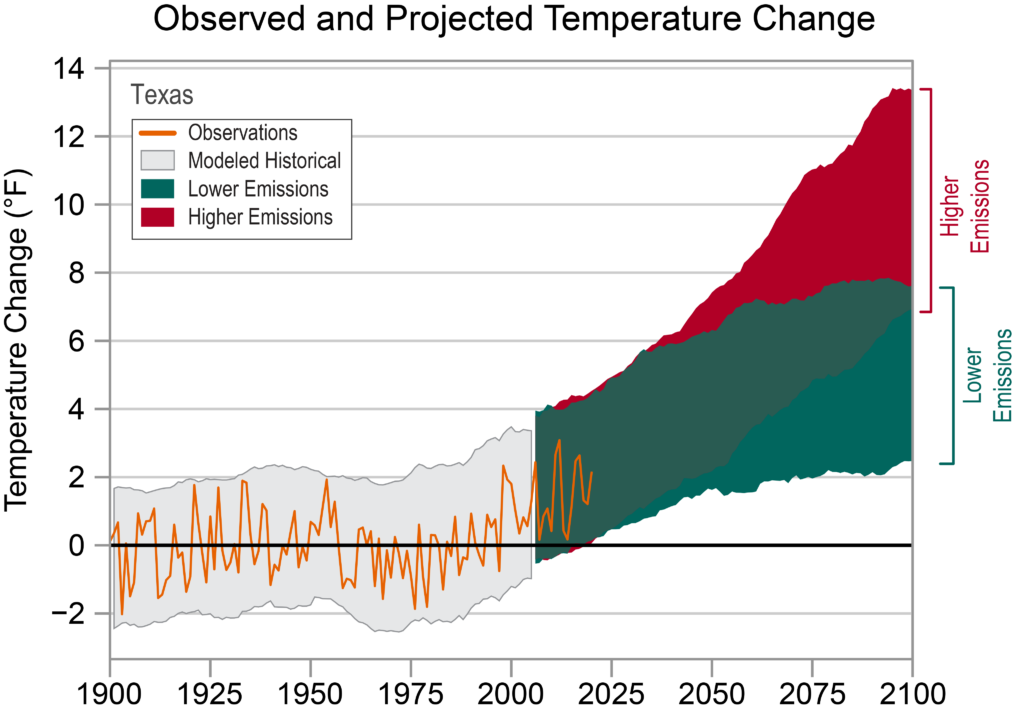Introduction:
During the summer of 2023, the Electric Reliability Council of Texas, ERCOT, announced that Texas broke peak demand records ten times, a single-year record. ERCOT issued several conservation requests over the summer and declared a power emergency on September 6th. Fortunately, the measures taken to bring on emergency power and shut down some industries prevented rolling blackouts.
Texas suffered its second-hottest summer, behind only that of the 2011 scorcher. According to the National Oceanic and Atmospheric Administration (NOAA), the average June through August temperature has increased by about 2 degrees Fahrenheit since 1901. (See figure 1.) Meteorological records indicate record-breaking heat waves have occurred more frequently in recent decades. Even overnight temperatures have been so warm that it has been over twenty years since we’ve had overnight temperatures cooler than the 20th-century average low. Given the expectation that the climate will keep warming, ERCOT will be challenged to maintain power in the face of increased demand for cooling power.

One simple and resilient solution to this problem is introducing additional incentive programs to encourage homeowners and commercial building owners to install grid-tied solar systems to help alleviate the load. I’ll provide five reasons a distributed solar system would help beat Texas heat.
Solar’s Timely Peak Output:
One of the best reasons distributed solar stacks up to other renewable sources is that the peak heating hours closely coincide with peak solar power generation. The sun’s peak output on clear days is between 1 p.m. and 3 p.m. Coincidentally, the hottest time is 3 p.m. as the sun’s angle presents the most direct solar radiation to surfaces. The Austin area experiences 6.86 sun hours in the summer months of June, July, and August. For the last several years, high-pressure systems have dominated the summer weather with few cloudy days to reduce the ability of solar systems to extract power.
Relieving Grid Stress:
After the ice storms of 2021 knocked out power for days for tens of thousands of people and led to the death of dozens, Texas and ERCOT committed to increasing the reliability of the power grid. The grid came within hours of a total shutdown that could have taken days to weeks to restore. The ERCOT declaration of a power emergency on September 6th indicates that severe summer heat carries the same risk of grid failure as winter ice storms. To reduce the probability of this event, it is necessary to improve the grid’s resiliency, and distributed solar systems should be a top choice as a solution.
Consider, first, the drawbacks of other power generation solutions. The construction of new gas power plants is viable but doesn’t help with the environmental issue of reducing greenhouse gasses. They also run into regulatory and environmental issues with site location and the typical not-in-my-yard protests to new sites. As of 2022, wind power makes up 24% of Texas’s power sources, but additional installations require expensive upgrades to the transmission line infrastructure, and their power generation is intermittent. This latter issue results in power not being available when it’s needed. Much research has been devoted to developing power storage mechanisms to allow power distribution when needed. Still, the current storage systems are not robust enough to handle the load. Finally, several companies like Anheuser Busch, Davita, and Target have developed large megawatt-scale solar projects. However, these suffer from the same transmission line issues as wind farms and serve as single-point-of-failure systems that could be knocked out in adverse weather events.
Distributed solar systems provide an opportunity to alleviate grid stress because they’re installed where needed and on freely available space – urban rooftops. The power grid is already present and capable of handling the loads. According to the Solar Energy Industries Association, Texas has installed almost 19,000 megawatts of solar systems. Given the increase in solar system efficiency and decrease in installation costs, the state would benefit by emphasizing a program to install more rooftop systems, both residential and commercial.
Distributing these systems across vast swaths of Texas reduces the chance of single-point-of-failure. The power generated coincides with peak demand, reducing the need for additional generation systems online if enough solar is installed.
Grid Resilience During Extreme Weather:
We’ve discussed how peak solar coincides with peak sun output, which, if enough solar is installed, helps provide a base power level that reduces draw on the entire power grid. If this base level is large enough, it reduces the demand on the system, which is a form of resilience. However, in the winter, the lower sun angle and more frequent cloudy days reduce the base. Those households and businesses that use gas to heat their buildings reduce the load on the system, and if they have an extensive enough solar power system, they may be able to feed power back onto the system. This may help add resilience to the system, but if an ice storm knocks out power lines or shuts down gas plants like occurred in 2021, a solar system won’t help.
However, if a household were to install a battery storage system along with their solar panels, they would (at a cost) be able to maintain a limited power availability in case of a line outage to their home. The addition of battery storage systems also allows home and business owners to store energy during off-peak hours and draw stored power during peak hours to reduce the load on the grid. Encouraging the installation of battery storage systems could be emphasized by incentives to reduce peak hour rates for those who draw on their storage when conservation measures are requested.
Economic Benefits for Home and Commercial Building Owners:
During the summer months of Jue, July, and August, Central Texas has an average of 6.86 peak hours of sun. A house with room on the roof to install ten 400-watt panels (4kW) during the summer would produce an average of 832 kWh per month. Over the last three years, my house has drawn, during these summer months, an average of 1605 kWh per month. This means, including some energy efficiency losses, that the power portion of my electric bill would be reduced by 50% on average. My bill, however, includes some up-front charges that reduce that percentage to 40%. I saw a house in my neighborhood with 24 panels installed. Assuming they were 400-watt panels, that would be 9.6 kW of panels providing 65.9 kWh daily. That averages out to about 1,998 kWh per month, and assuming they consumed the same power as my house, they would be providing power to the grid and receiving net metering income.
Installing solar systems on large office buildings, hospitals, factories, and warehouses presents opportunities to reduce power utility costs significantly. Parking garages could install solar panels as shading for the top level and provide building owners with net metering income as the lighting power demand of the open building would be low.
Environmental Sustainability:
The economic benefits of installing distributed solar systems are augmented by the environmental benefits of this green energy source. The energy density of fossil fuels ensures that petro-powered plants will be a part of the energy portfolio for some time. However, given the decreasing cost and increasing efficiency of solar power, increasing the solar footprint and base energy profile reduces the need to add more gas-fired plants. The more we rely on solar and other renewable energy sources, the less we need to rely on fossil fuels to power our nation.
Many suggest that we wean the world entirely from fossil fuels as sources of our energy. This may be possible with advances in renewable energy sources and power storage systems, but it is likely a few decades away. However, that’s not a reason to stick our heads in the sand. Providing incentives to install distributed solar systems is feasible, possible, and valuable to driving the world to cleaner energy. The payback period may be lengthy, but working now to install these systems helps provide our children and grandchildren with a cleaner future. According to a study by Nature, distributed solar also provides ecological benefits as the installation uses existing rooftops, which do not require additional impacts on land use.
Challenges and Considerations:
Distributed solar power cost reduction and environmental benefits incentivize homeowners and businesses to install the systems. However, the installation costs, while shrinking steadily, still present a barrier to adoption. Texas ranks second in the nation for providing solar incentive programs, but more could be done.
The biggest holdback to providing beefier incentives is that fossil-fueled power plants and the petroleum industry may see decreased incomes with decreased demand for power as solar systems increase. These deep-pocket industries lobby legislators heavily to slow or reduce the offer of solar incentives. The Texas Tribune reports state lawmakers sought to restrict the adoption of renewable energy as most have turned against green energy ideas on purely partisan political grounds.
However, green energy should not be not the primary consideration. Installing distributed solar systems financially benefits home and business owners with reduced power costs. Additionally, communities benefit from the economic opportunity of adding hundreds of jobs for solar system designers and installers. According to the Interstate Renewable Energy Council (IREC), the solar industry employed almost 264 thousand in 2022, with a 3.5% increase in jobs over 2021. Why would politicians want to deprive their communities of this chance of good-paying jobs?
Conclusion:
As long as Texas maintains a power grid separate from the national grid, the chance of extreme weather events causing massive grid failure remains very probable. If we increase the coverage of solar power across rooftops, the ability of the grid to sustain power in weather events would be improved. Both commercial buildings and homeowners would see a reduction in their energy bills. Using a tiny piece of Texas’ nine billion dollar rainy day fund for incentives would reduce installation payback periods to attractive levels. The financial, grid resilience, and environmental benefits should be more than enough to offset the income loss concerns of power generators. Texas faces continuing, if not increasing, scorching summer heat, and distributing solar power coverage across the state can only improve our ability to keep Texas powered.

